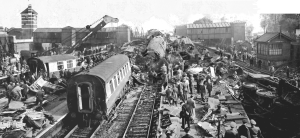Introduction
In the annals of railway history, certain incidents stand out not only for their impact on transportation but also for the profound lessons they impart. The Harrow train derailment of 1952 is one such tragic event that shook the foundations of rail safety and prompted crucial reforms in the industry. This article delves into the details of the Harrow derailment, exploring its causes, consequences, and the lasting changes it brought to railway safety.
The Fateful Day: October 8, 1952
The sun had barely risen on that fateful morning when the calm of Harrow and Wealdstone, a quiet suburban town in northwest London, was shattered by a catastrophic event that would change the course of railway history. At approximately 8:19 am, an express passenger train bound for Scotland, comprising nine carriages hauled by two locomotives, derailed just north of Harrow and Wealdstone station. What followed was a scene of unimaginable devastation and tragedy.
Causes and Immediate Consequences
The Harrow train derailment was caused by a confluence of factors, with human error and poor communication at the forefront. A freight train had stopped on the same track due to a broken axle, and the signalman mistakenly cleared the path for the express passenger train. This disastrous error meant that the oncoming express train had no warning of the impending danger ahead. The result was a horrifying collision with the stationary freight train, followed by the derailment of several carriages.
The impact was immediate and catastrophic. Carriages were torn apart, and debris was scattered across the tracks and surrounding areas. The death toll was staggering, with 112 people losing their lives and over 340 others sustaining injuries of varying degrees. The aftermath of the disaster was marked by emergency services rushing to the scene, survivors recounting tales of horror, and a community left in shock and mourning.
Investigation and Lessons Learned
In the wake of the Harrow train derailment, a comprehensive investigation was launched to determine the root causes and prevent future occurrences. The findings highlighted the pressing need for reforms in various aspects of railway operations and safety protocols. The investigation identified the lack of proper communication between signalmen, inadequate training, and the absence of modern safety measures as significant contributing factors.
This tragedy marked a turning point in the history of railway safety. The Harrow derailment served as a sobering reminder of the potential consequences of negligence and highlighted the necessity for standardized safety procedures and enhanced communication systems. The investigation led to a series of recommendations, which were subsequently adopted to prevent similar incidents in the future.
Legacy and Lasting Reforms
The Harrow train derailment spurred a series of lasting reforms that reshaped railway safety practices for years to come. Some of the key changes include:
- Improved Signaling Systems: The importance of efficient signaling systems was underscored by the accident. In response, railways invested in advanced signaling technologies that allowed better coordination between stations and provided early warnings about track conditions.
- Enhanced Training: The investigation revealed that proper training for signalmen and other personnel was lacking. To address this, comprehensive training programs were developed to ensure that every railway employee was well-versed in safety protocols and emergency procedures.
- Standardized Communication: Clear and standardized communication protocols were established to avoid confusion and misunderstandings between signalmen, train drivers, and other staff members. This ensured that critical information was conveyed accurately and promptly.
- Safety Inspections: Regular safety inspections and maintenance of tracks, locomotives, and carriages were implemented to identify and address potential issues before they escalated into disasters.
- Passenger Safety: The tragedy underscored the importance of designing passenger carriages with safety in mind. Modern carriages were equipped with safety features like reinforced structures, emergency exits, and safety glass to minimize casualties during accidents.
- Emergency Response: The accident highlighted the need for coordinated emergency response efforts. Emergency services and railway staff developed improved strategies to handle similar incidents swiftly and efficiently.
Conclusion
The Harrow train derailment of 1952 remains etched in history as a stark reminder of the consequences of complacency and inadequate safety measures in the railway industry. The tragedy led to a transformation of railway safety practices, emphasizing the need for improved communication, training, and technological advancements. While the event brought about immense sorrow and loss, it also catalyzed positive change, making the railways safer for future generations. As we reflect on this poignant incident, we are reminded that even in the face of tragedy, humanity can learn, adapt, and emerge stronger.





1 comment